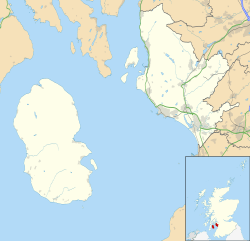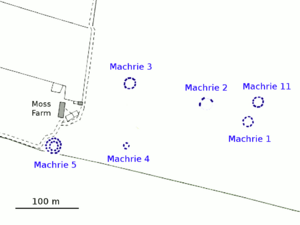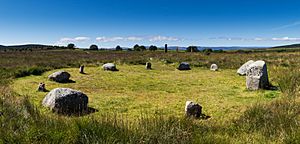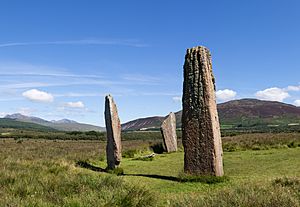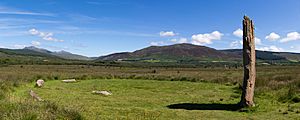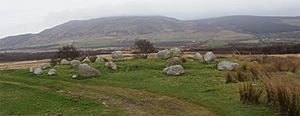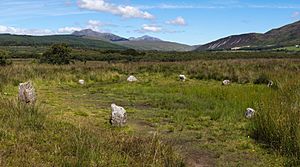Machrie Moor Stone Circles facts for kids
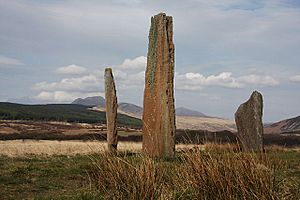
Machrie Moor Stone Circle 2
|
|
| Location | Isle of Arran |
|---|---|
| Coordinates | 55°32′27″N 5°18′49″W / 55.540829°N 5.313655°W |
| Type | Stone Circles |
| History | |
| Periods | Neolithic / Early Bronze age |
| Site notes | |
| Ownership | Historic Scotland |
| Public access | Yes |
The Machrie Moor Stone Circles are a group of six ancient stone circles. You can find them on Machrie Moor, close to the village of Machrie on the Isle of Arran in Scotland. These mysterious circles were built a very long time ago, during the Neolithic (New Stone Age) and early Bronze Age.
Discovering the Machrie Moor Circles
Six stone circles stand on the moor, just east of an old farm called Moss Farm. Some circles are made from large, round granite rocks. Others are built with tall, red sandstone pillars. The moor is also home to many other ancient remains. These include single standing stones, burial mounds called cairns, and stone boxes known as cists.
Scientists have found that these stone circles were built on top of even older wooden circles. For example, the wooden circle under Machrie Moor 1 dates back to about 2030 BCE. You can also spot old hut circles, which look like low rings of stones covered by grass.
The six stone circles are placed below a special spot on the skyline to the northeast. This spot is where Machrie Glen splits into two steep valleys. During the summer solstice (the longest day of the year), the sun rises right through this notch. This might be why these circles were built in this exact place.
A person named James Bryce first recorded these stone circles in 1861. He numbered them 1 to 5. Other ancient sites nearby were numbered 6 to 10. Later, in 1978, another stone circle was found almost completely hidden in the peat. This one was named Machrie Moor 11. About one kilometer to the west, you can find the remains of the Moss Farm Road Stone Circle, which was originally called Machrie Moor 10.
Machrie Moor 1: The Granite and Sandstone Mix
Machrie Moor 1 is shaped like an oval. It measures about 12.7 meters by 14.6 meters. This circle is made from a mix of six granite boulders and five sandstone slabs, placed one after the other. Four of the granite blocks have fallen over.
Machrie Moor 2: The Tallest Stones
Machrie Moor 2 is the most impressive circle to see. It is about 13.7 meters wide. It probably had seven or eight tall sandstone slabs originally. Today, three of these stones are still standing tall. The other stones are just stumps. The three standing stones are very tall, ranging from 3.7 meters to 4.9 meters high. Inside the circle, there are two large stones that seem to have broken off a fallen pillar. One of these stones has a hole in the middle, as if someone started to turn it into a millstone.
When people dug here in 1861, they found a stone box, called a cist, in the center of the circle. Inside this cist, they found a "food vessel," which was a type of pottery pot. Another empty cist was found between the center and one of the standing stones.
Machrie Moor 3: The Egg-Shaped Circle
Machrie Moor 3 originally had nine stones. Only one stone is still standing, and it is 4.3 meters tall. The stumps of the other stones are partly visible in the peat. These stones form a unique egg-shape.
During the 1861 excavations, a small cist was found in the center. It held an urn (a pot for ashes) with some burnt bone pieces and small flint flakes. Another cist was found about 1 meter south of the center. This one contained a crouched burial (a body buried in a curled-up position) along with some more flint flakes.
Machrie Moor 4: The Small Granite Circle
Machrie Moor 4 is made up of four granite blocks, each about 0.9 meters high. In 1861, a cist was found in the center of this circle. Inside it was a human burial, a food vessel, a bronze awl (a small pointed tool), and three flint flakes.
Machrie Moor 5: Fingal's Cauldron Seat
Machrie Moor 5 is also known as "Suidh Coire Fhionn" or "Fingal's Cauldron Seat." This circle has two rings of granite boulders, one inside the other. The inner circle is 12.0 meters wide and has eight granite boulders. When people dug here in 1861, they found an empty, broken cist in the center. The outer circle is about 18.0 meters wide and has fifteen granite boulders. This outer circle is also said to be shaped like an egg.
Machrie Moor 11: The Hidden Circle
Machrie Moor 11 is a low stone circle, about 13 meters wide. The tallest stone in this circle is about 1.2 meters high on the western side. When archaeologists dug here in 1978-79, they found 10 standing stones. They also found a pit between each stone, which might have been where wooden posts once stood.
Other Ancient Remains on Machrie Moor
James Bryce also listed five other ancient sites to the west of the stone circles in 1861.
- Machrie Moor 6 is what's left of a possible chambered cairn. This is a type of ancient burial mound with a stone chamber inside. It has two upright stone slabs touching each other at right angles.
- Machrie Moor 7 is a single standing stone, 1.6 meters tall.
- Machrie Moor 8 is the remains of another probable chambered cairn. It's an oval area of stones, about 20 meters by 16 meters. The most noticeable part is a 1.8-meter-tall standing stone within the east edge of the cairn. It's surrounded by smaller stones that might have been part of a chamber or a decorative front.
- Machrie Moor 9 was a standing stone, but there's no clear trace of it left today.
- Machrie Moor 10 is the Moss Farm Road Stone Circle.
Around 1.2 kilometers east of the Machrie Moor Stone Circles, near the B880 road, there's another group of stones. It has three granite boulders and might have originally had four stones.
Images for kids


